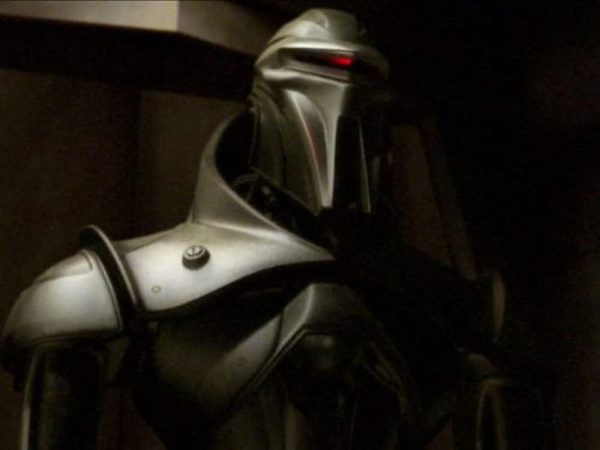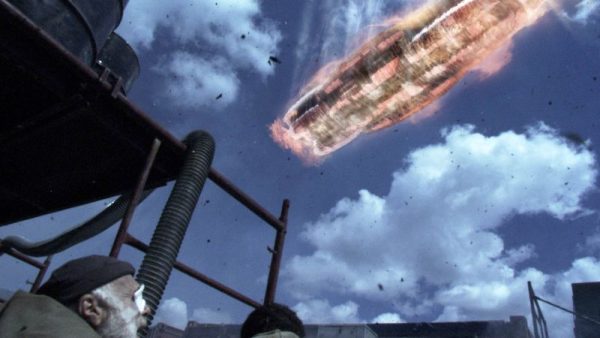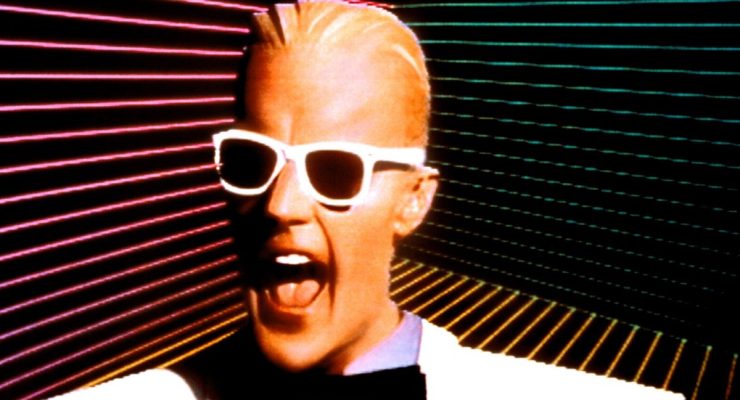Ricky Church remembers Battlestar Galactica…
In today’s climate of film and television, its pretty common for an old property to be rebooted or remade for a modern audience. The last several years have seen it done so many times with various series or films, from Batman, Lethal Weapon, Magnum P.I., The Jungle Book and Twin Peaks, reboots have been a dime and dozen and often not lived up to the original.
But flashback to 2003 when they weren’t as common. One classic 1970s series was remade into something more serious and gritty, but with powerful characters, stories and themes. That show was Battlestar Galactica, which premiered with its miniseries back in 2003 before launching into its first full season the following year.
The original 70s series of Battlestar followed a ragtag group of humans on the verge of extinction after the Cylons, a race of robotic beings, launched a surprise attack on humanity and largely wiped out the population. The few survivors band together in search of their mythical colony, Earth, as their new home.
While the show was fun and campy, the reimagined series was anything but as Ronald D. Moore, a writer and showrunner for Star Trek: The Next Generation and Deep Space Nine, took the franchise to a whole new level as he adopted a realistic and grounded approach to the story. What Moore ended up doing, in my opinion, surpassed the original series and delivered some of the best sci-fi television ever made.
The miniseries brought some sweeping changes to the original series that used post-9/11 culture as a huge influence. Some of the imagery the miniseries uses during the Cylon attacks is quite evocative of 9/11, from Baltar watching live footage of a nuclear explosion, huge plumes of smoke seen miles away to the scattered rumours collected on various spaceships on the attacks. The show let audiences know right away this wasn’t going to be the fun, adventure filled, kid-friendly series of the 70s, but something deeper to examine current societal events and history.
Rather than being a race of aliens, the Cylons were created by humanity before revolting and going into self-imposed exile for 40 years. During that time, they evolved from simple robotic drones into humanoid copies that looked and acted like people, a move that allowed the show to play off the character’s paranoia that anyone could be a Cylon whole also examining what makes them human.
Though there are 12 models of Cylons, each one has the capacity to act differently from their model instead of following a bland code, something that makes a few of the Cylons, such as Caprica Six, Boomer and Athena, quite unique from the rest. Through this, Battlestar Galactica examined one of the big themes of the series: what makes us human, even if, perhaps especially in, the face of the apocalypse?
Edward James Olmos’ Commander Adama lays down this theme in the miniseries by asking an audience made up of military personnel, politicians and journalists what makes humanity a species worth saving. This one little question branches several other themes on family, love, loyalty, torture and many more as the series attempted to give an answer.
Battlestar provided some very deep and thought-provoking themes, especially when it came to the morality of war. The topics of suicide bombers, interrogation torture, military conscription are all brought up at one point or another.
Perhaps one of the big sticking points to the series in these themes was the arrival of the Battlestar Pegasus, another Battlestar that had survived the Cylons big attack. Due to their different circumstances though they took a much different path than the Galactica as they waged a guerrilla war against the Cylons and lost their humanity along the way as they resorted to torture, killing and forcefully conscripting civilians and even rape to achieve their goals.
That was one thing about Battlestar that separated it from many other shows; it was unafraid to go places most shows were. From its discussions on rape, ethics, religion, racism and war, there seemed very little it wouldn’t talk about. One episode that has always stuck with me is Season 2’s ‘The Captain’s Hand’ which discusses a topic many shows try avoiding: abortion.
Though the episode and character of President Roslin took the stance of pro-choice, it examined it from the position of humanity’s near-extinction which forced Roslin to ban it for the survival of the species. It was a very risky position to take, but where most shows use abortion for dramas sake Battlestar discussed it in a serious and respectful manner.
Of course, the power of discussions such as those only succeed because of the greatness of the show’s cast. From Olmos, Mary McDonnell, Katee Sackhoff, Jamie Bamber, Tricia Helfer, James Callis and the rest of the ensemble, Battlestar‘s cast gave it their all. Over the course of its four season run, as well as its few web-series and feature specials, the cast delivered some truly emotional and powerhouse performances.
What makes them and their characters so endearing, though, is they are presented as flawed people from start to finish. None of them are perfect, even the moral paragon that is William Adama. It presented them as real people that were allowed to have faults and failures, yet still grow. Each character goes through some remarkable development even with their flaws, particularly Callis’ Gaius Baltar, that makes them feel relatable and human. Battlestar delivered some great character examinations that were given by an even better group of actors. There was one character, though, that hung over all the others: Battlestar Galactica herself.
Much like the USS Enterprise, Galactica became a character unto herself. The ship came to mean home and safety for everyone in the fleet and it felt like a character thanks to the way Adama, Roslin, Colonel Tigh and others spoke about it. Adama’s history with the ship, being the first Battlestar he was assigned to and the ship he was meant to retire on, held so much weight that it was easy to see why he treated it like another family member.
Throughout various moments in the show, particularly its battle scenes, every scrape, dent and blast the ship received was felt. The final moments of the Galactica, with Adama doing his own flyby of it to say goodbye, was a great and emotional send-off for the old girl.
Battlestar Galactica is also home to some of the best action on sci-fi television ever. Considering this was a TV series, some of the battles it depicted were quite epic and displayed some very impressive visuals effects. It helped the show’s budget that the majority of the series was filmed indoors on sets, allowing the visuals to have a little more heft to them, and space battles were well choreographed and held quite a bit of tension.
One of the series’ finest action moments was the battle in Season 3’s ‘Exodus (Part 2)’ where the Galactica attempted to rescue the residents of New Caprica from the Cylon occupation and what became known as The Adama Maneuver in a crowd-pleasing, emotional and action-packed sequence that I hadn’t seen utilized by any starship in any series. Even the very few ground battles in the show were tension-filled and well executed, making the new Cylon Centurions quite a fearsome and deadly enemy to go up against. The height of the series’ action, though, may yet be the battle in the series finale ‘Daybreak’.
In many of the conversations I’ve had about the reimagined series, very few of them are had without ‘Daybreak’ and the ending getting brought up. Battlestar had an ending that seems to be just as divisive as Lost where some fans are happy with the character’s endings and the answers it presents, and some are unhappy with what the direction the show took and the lack of answers for certain questions.
For my part, I believe Battlestar Galactica has one of the best series finales that has ever been made that delivers on a very emotionally impactful note. Though some things may have been better explained or clarified, such as what Starbuck was or the true nature of the Virtual Six and Baltar, I think the show provides enough answers throughout its run that it doesn’t matter if ‘Daybreak’ didn’t explicitly state some of the answers. The hints and clues provided are enough for viewers to figure out or come up with their own interpretations on their own.
And that is what Battlestar Galactica is at its heart: a show about characters, whether they’re human or Cylon, discovering who they truly are. Audiences are brought along on the journey with them and forced to ask the same questions and go through the same problems the crew of Galactica and the Colonial Fleet deal with. This is exactly why ‘Daybreak’ is such a successful ending for me.
The series’ rumination on faith and where the characters go from there is built directly from that first question Adama asks in the minieries: what makes humanity worthy of survival? While the big mysteries are left open to interpretation, this question is made up of several answers but they all relate back to the human condition and the personal connections we make. If any character is an encapsulation of that, it’s Baltar. Just look at where he began in the miniseries to his final line and breakdown in the finale for his arc.
Almost twenty years on from its premiere, Battlestar Galactica remains one of the most well-produced, written and acted shows made. It’s legacy and impact has been so strong its cast was even invited to the United Nations to discuss some of the show’s more powerful and serious messages. There is just so much to love about Battlestar, from the cast, characters, themes, battles to Bear McCreay’s amazing score throughout the whole run.
Ronald D. Moore did a great job not just bringing Battlestar Galactica back, but elevating it to a whole new status as one of the most affecting pieces of science fiction and remakes brought to screens. So if you’re looking for a new show or just want to revisit this classic, then grab your gun and bring in the cat. So say we all.
Ricky Church























